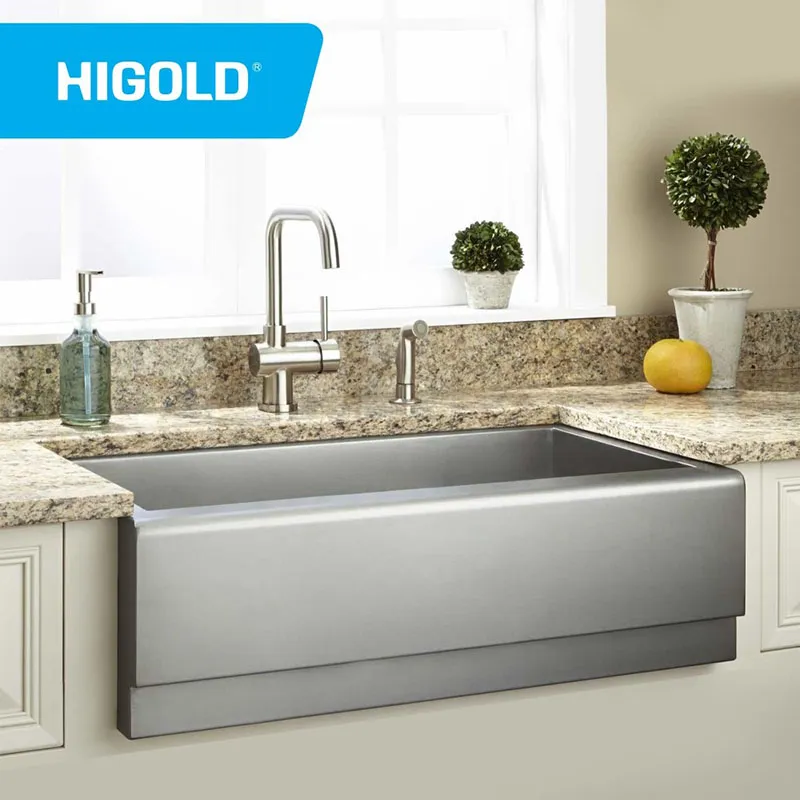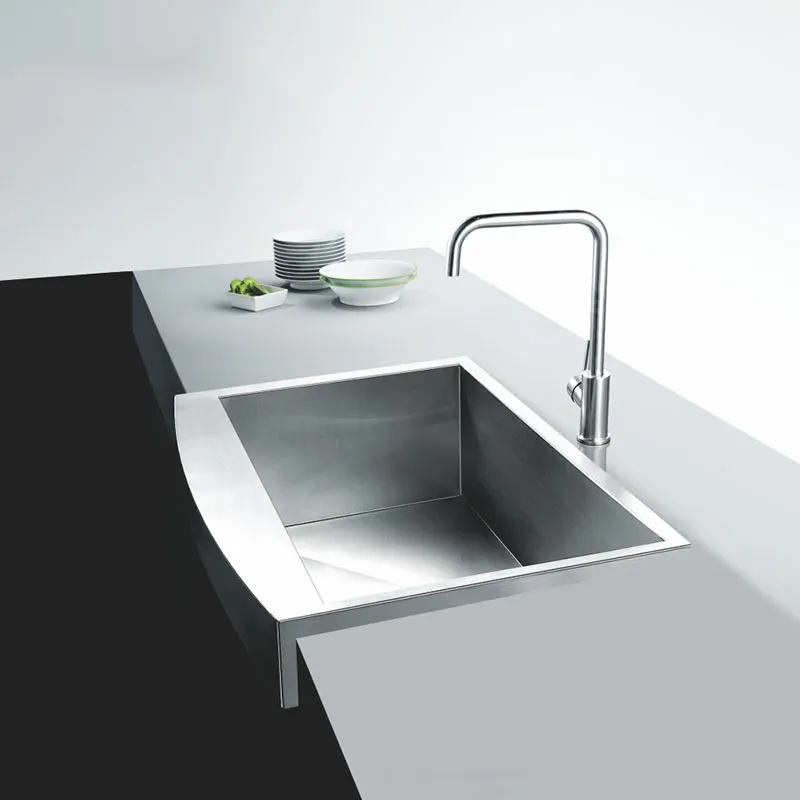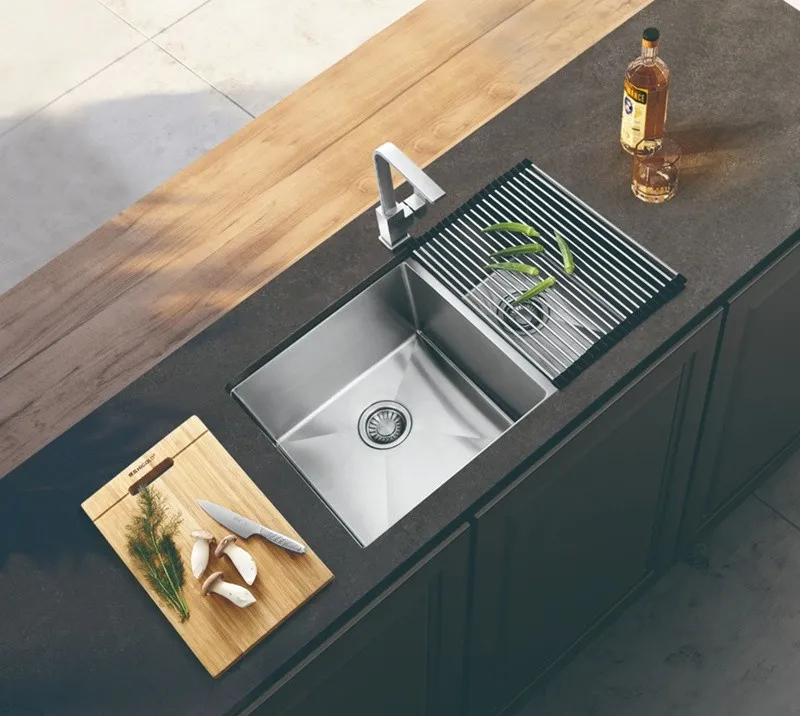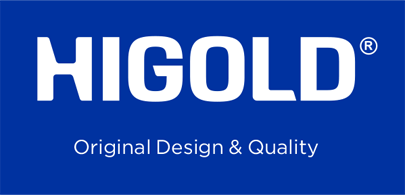As an essential functional component of the kitchen, the material and craftsmanship of the sink have gradually become a focus of consumer attention. Among them, "brushed stainless steel sinks," with their unique texture and durability, are increasingly becoming a popular choice in kitchen design.
So, what exactly is a brushed stainless steel sink? Are its advantages and performance truly superior to traditional sinks? This article will provide readers with a comprehensive and professional interpretation from the perspectives of materials, craftsmanship, performance, and applicability.

What is a Brushed Stainless Steel Sink?
A brushed stainless steel sink refers to a kitchen sink made of stainless steel that has undergone a brushing process. Stainless steel is a material made by alloying iron with elements such as chromium and nickel, possessing excellent corrosion resistance and mechanical strength. The brushing process involves mechanically polishing the surface of stainless steel to create fine, uniform lines, giving the metal a matte or silky sheen.
Brushed stainless steel sinks are typically made of 304 or 316 stainless steel:
From a material perspective, brushed stainless steel sinks usually use 304 or 316 stainless steel. 304 stainless steel is the most widely used material in kitchens, with a chromium content typically between 18% and 20% and a nickel content of approximately 8% to 10%, possessing excellent oxidation resistance. 316 stainless steel, on the other hand, adds molybdenum to 304, enhancing its resistance to chloride corrosion, but it is more expensive and mostly used in high-end kitchen environments.
Brushed Stainless Steel Sinks: Are They Better?
The popularity of brushed stainless steel sinks stems primarily from the textured effect of their brushed surface treatment. The brushing process not only effectively conceals minor scratches from daily use but also increases the sink's surface resistance to stains, making it less likely for water droplets, oil stains, and other dirt to adhere noticeably, thus improving the overall aesthetics and ease of cleaning in the kitchen.

What is the manufacturing process for brushed stainless steel sinks?
The manufacturing process of brushed stainless steel sinks is a crucial guarantee of their performance and aesthetics. Generally, the production process of brushed stainless steel sinks includes five main steps: material selection, stamping, brushing and polishing, welding and assembly, and surface treatment.
1. Material Selection
High-quality stainless steel sheet is the foundation for producing brushed sinks. Typically, 304 stainless steel sheet with a thickness of 1.0mm to 1.2mm is used to ensure the sink will not deform during long-term use.
2. Stamping
Using precision stamping equipment, the stainless steel sheet is processed into the basic shape of the sink. The precision of the stamping directly affects the neatness of the sink's edges and its installation adaptability.
3. Brushing and Polishing
This is the most crucial process for brushed stainless steel sinks. Craftsmen use grinding wheels or polishing machines to systematically polish the surface of the sink, creating a uniform and fine texture. There are usually two brushing directions: horizontal and vertical. Different brushing directions present different visual effects under light.
4. Welding and Assembly
Modern brushed stainless steel sinks often adopt a multi-piece assembly structure, such as double-bowl sinks or multi-functional sinks with accessories. The welding process requires high precision, ensuring smooth weld seams to prevent difficulties in later cleaning.
5. Surface Treatment
After brushing, grinding, and welding, the sink undergoes pickling or passivation to further improve corrosion resistance and ensure a pristine surface.
Through these processes, brushed stainless steel sinks not only possess a unique metallic texture but also maintain their aesthetic appeal and durability during daily use.

Brushed Stainless Steel Sinks: What are their advantages?
The popularity of brushed stainless steel sinks in the market is primarily due to their comprehensive performance advantages. The following analysis examines these advantages from multiple perspectives:
1. Aesthetics
Brushed stainless steel sinks exhibit a natural, silky sheen, complementing modern minimalist, industrial, and Chinese modern kitchen designs. Compared to polished stainless steel sinks, brushed surfaces are less prone to fingerprints and water stains, maintaining a visually clean appearance. Even under strong light, their low reflectivity prevents glare, creating a more comfortable kitchen environment.
2. Corrosion Resistance
Because brushed stainless steel sinks are typically made of 304 or 316 stainless steel, they possess natural antioxidant properties. In everyday kitchen environments, sinks frequently come into contact with water, salt, detergents, and acidic or alkaline substances from food. Brushed stainless steel sinks effectively resist corrosion and rust, extending their lifespan.
3. Wear Resistance and Scratch Resistance
The brushed finish not only enhances the aesthetics but also strengthens the sink's wear resistance. Compared to smooth stainless steel sinks, the brushed texture disperses scratches, making them less prone to showing minor scratches over long-term use. Even when using metal tableware or cleaning brushes, the surface remains relatively intact.
4. Easy Cleaning and Maintenance
The surface of brushed stainless steel sinks is highly hydrophobic, allowing water droplets to easily run off and preventing water stains. Cleaning only requires a neutral detergent and a soft sponge; frequent use of strong acid or alkaline cleaners is unnecessary, reducing the risk of chemical corrosion and simplifying maintenance.
5. Healthy and Environmentally Friendly
Stainless steel itself is non-toxic and harmless, and does not release harmful substances, making it suitable for food contact environments. Brushed stainless steel sinks undergo rigorous surface treatment, further ensuring kitchen hygiene and safety, making them an important choice for healthy kitchens in modern families.
What are the limitations of brushed stainless steel sinks?
While brushed stainless steel sinks have significant advantages in aesthetics and durability, they still have certain limitations in practical applications:
• Relatively High Price: Compared to ordinary smooth stainless steel sinks or ceramic sinks, brushed stainless steel sinks have a more complex processing technology, resulting in a relatively higher cost.
• Higher Requirements for Installation Environment: Due to the thinner material, improper installation and support may cause slight deformation or noise during use, requiring professional installation.
• Limited High-Temperature Resistance: Although stainless steel has good heat resistance, directly placing hot pots or prolonged boiling water may cause slight changes in the brushed texture due to thermal expansion and contraction, so care is still needed in daily use.

Brushed Stainless Steel Sinks: Suitable for Which Kitchen Environments?
From an application perspective, brushed stainless steel sinks are suitable for a variety of kitchen environments. Its corrosion resistance and easy-to-clean properties make it suitable for home kitchens, commercial kitchens, and newly renovated apartments. Especially for families seeking a kitchen that combines aesthetics and practicality, brushed stainless steel sinks can meet daily washing, food preparation, and multi-functional cooking needs.
Furthermore, brushed stainless steel sinks offer design flexibility. Common styles include single bowls, double bowls, and multi-functional sinks with accessories, which can be selected according to kitchen space and usage habits. The brushed surface complements various countertop materials (such as quartz, granite, and artificial stone), achieving a unified and aesthetically pleasing kitchen.
Brushed Stainless Steel Sinks: How to Choose? – Recommendations
When purchasing a brushed stainless steel sink, consumers should pay attention to the following aspects:
• Material Selection: Prioritize 304 or 316 stainless steel, avoiding low-cost 18-8 stainless steel or inferior steel to ensure corrosion resistance and lifespan.
• Brushing Craftsmanship Quality: Observe whether the brushed texture on the sink surface is uniform and whether the brushing direction is consistent. The fineness of the brushing directly affects the sink's aesthetics and wear resistance.
• Thickness and Structure: The sink thickness should be between 1.0mm and 1.2mm. A bottom with shock-absorbing pads or a thickened design can be chosen to reduce noise and deformation risks.
• Installation Method: Choose a countertop, undermount, or built-in sink based on your kitchen countertop type, ensuring a stable and well-sealed installation.
• Accessories and Functions: Ensure all sink accessories are included, such as a sink strainer, drain basket, and matching drainage system, enhancing daily convenience.
Brushed Stainless Steel Sinks Compared to Other Sink Materials: Comparison
To better understand the advantages of brushed stainless steel sinks, compare them with common sink materials:
• Ceramic Sinks: Ceramic sinks have a smooth surface and are heat-resistant, but they are fragile, have low impact resistance, and are prone to cracking and glaze peeling over time. Brushed stainless steel sinks are significantly superior to ceramic sinks in terms of durability and scratch resistance.
• Composite Material Sinks: Composite material sinks are lightweight and highly malleable, but are susceptible to thermal expansion and chemical corrosion, making them less durable than stainless steel. Brushed stainless steel sinks offer superior strength and corrosion resistance.
• Polished Stainless Steel Sinks: Polished sinks have a high gloss finish, but are prone to fingerprints, water stains, and scratches. Brushed stainless steel sinks, with their brushed texture, effectively conceal scratches and water stains, making maintenance easier.
In summary, brushed stainless steel sinks offer significant advantages in corrosion resistance, aesthetics, and durability, making them particularly suitable for modern kitchens that prioritize both practicality and aesthetics.
How flexible is Higold in accommodating customized designs?
Higold’s in-house engineering team allows for deep customization, from adjusting bowl configurations and corner radii to creating brand-exclusive finishes. With automated tooling and robotic systems, the factory can quickly adapt to different buyer requirements. Customized orders come with detailed quotes and technical support, making Higold a leading ODM manufacturer in China.


